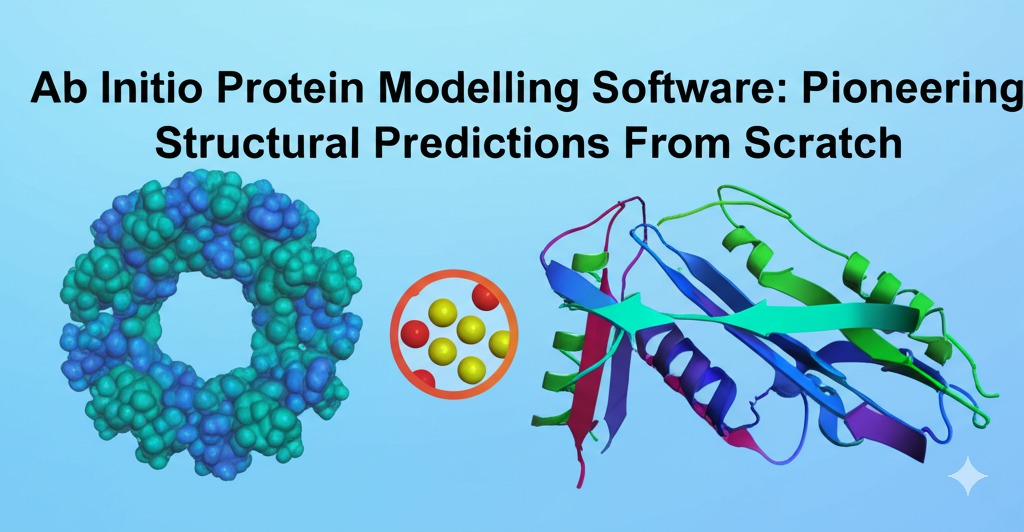Ab Initio Protein Modelling Software: Pioneering Structural Predictions from Scratch
Proteins are the workhorses of biology, responsible for countless cellular processes. Understanding their 3D structure is crucial for everything from drug design to disease research. But what if no experimental structure exists for a given protein? That’s where ab initio protein modelling software steps in—offering a way to predict a protein’s structure entirely from its amino acid sequence.
In this article, we’ll explore what ab initio modelling is, how it differs from other approaches, popular tools in the field, and how to choose the right one for your needs.
What Is Ab Initio Protein Modelling?
Ab initio modelling (also known as de novo modelling) is a computational method that predicts the 3D structure of a protein without using templates or homologous structures. Instead, it relies on fundamental physical and statistical principles to simulate how a protein might fold.
How It Works
- Energy minimization: The software seeks the lowest energy state, which corresponds to the most stable protein structure.
- Monte Carlo simulations: Random conformations are generated and iteratively refined.
- Fragment assembly: Short structural motifs from known proteins may be used to guide folding predictions.
This method is especially useful for novel proteins or sequences with no known homologs.
Ab Initio vs. Template-Based Modelling
Before diving into software options, it’s important to distinguish ab initio modelling from comparative (homology) modelling.
| Feature | Ab Initio Modelling | Template-Based Modelling |
|---|---|---|
| Requires known structure? | ❌ No | ✅ Yes |
| Accuracy for large proteins | ⚠️ Limited | ✅ High |
| Best for | Novel or orphan proteins | Proteins with known homologs |
Ab initio models are more computationally demanding and often less accurate for longer sequences, but they offer invaluable insights when no template is available.
Top Ab Initio Protein Modelling Software
Several tools have emerged as leaders in this space, offering various algorithms, interfaces, and degrees of usability. Here’s a closer look:
1. Rosetta
Rosetta is arguably the most well-known ab initio protein modelling suite.
- Features:
- Fragment-based folding
- High accuracy for small to medium proteins
- Extensive suite for docking, design, and prediction
- Best for: Advanced users with programming experience
- Interface: Command-line (with some GUI wrappers available)
⭐ Fun fact: Rosetta was instrumental in the success of AlphaFold competitors before deep learning dominated the scene.
2. QUARK
Developed by the Zhang Lab, QUARK is a powerful ab initio modelling server.
- Features:
- Physics-based force fields
- Incorporates threading for hybrid predictions
- Automated and web-accessible
- Best for: Users who prefer a simple web interface
- Interface: Web server
3. I-TASSER (Hybrid with Ab Initio Component)
While I-TASSER is primarily a threading-based tool, it integrates ab initio methods when templates are weak or absent.
- Features:
- Combines ab initio and template-based modelling
- Produces function predictions alongside structure
- Best for: Mid-range predictions where some template data may be available
- Interface: Web server and standalone versions
4. AlphaFold (Limited Ab Initio Behavior)
Although AlphaFold is driven by deep learning, it behaves similarly to ab initio tools when predicting proteins without homologs.
- Note: AlphaFold is not purely ab initio, but it’s worth mentioning due to its breakthrough accuracy and open-source availability.
Key Factors When Choosing Ab Initio Software
With several tools available, how do you pick the right one?
Consider These Questions:
- What is your protein size?
- Small proteins (<150 residues) yield more accurate results in ab initio tools.
- Do you have coding experience?
- Tools like Rosetta offer deep customization but require technical skill.
- Do you need speed or precision?
- Web tools like QUARK or I-TASSER offer convenience but may be slower or limited in customization.
- Is experimental validation part of your pipeline?
- Ab initio predictions are hypotheses and often require lab verification.
Challenges and Limitations
While revolutionary, ab initio modelling has its constraints:
- Computational cost: Simulating folding pathways is resource-intensive.
- Accuracy for large proteins: Decreases significantly as the sequence length grows.
- Ambiguity in folding: Multiple low-energy states can exist, making predictions uncertain.
Despite these, continuous algorithmic improvements and AI integration are steadily pushing boundaries.
Applications in Modern Research
Ab initio modelling is crucial in:
- Structural genomics: Filling the gap for uncharacterized proteins
- Drug discovery: Identifying novel binding pockets
- Protein design: Engineering new proteins with desired functions
- Synthetic biology: Constructing proteins from scratch for industrial or medical use
These applications underscore the real-world value of accurate ab initio predictions.
Final Thoughts: The Future of Protein Modelling
Ab initio protein modelling software continues to evolve rapidly, especially with the rise of machine learning-driven hybrid methods. While not yet perfect, these tools allow researchers to venture into uncharted protein landscapes, making discoveries that were previously out of reach.
Whether you’re a seasoned bioinformatician or a curious researcher stepping into the world of structural biology, understanding and leveraging ab initio tools is a valuable asset in your scientific toolkit.

Zain Jacobs is a writer for TheNetUse, providing in-depth reviews, tips, and insights on the latest software apps to help users maximize their digital experience.







